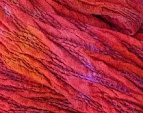In simple terms diversified plain weave has a thick thread forming the pattern and a fine thread providing a plain or tabby background and tying the thick threads down. Conventionally it is threaded 232,141,252 etc with shafts 1 and 2 being the tie threads and 3, 4, 5 etc being the thick pattern thread - usually about 4 or 5 times thicker than the ties. A new way to thread is 123, 124, 125 etc which I haven't tried. Weaving uses two shuttles and again two pics of fine thread weaving plain to one pic of the thick pattern thread.
How did I create the drawdown? That's a bit of a mystery but first I googled and came up with a few sites and Handwoven magazine has had various articles in recent times on diversified plain weave (DPW).
My inspiration was this paper which my daughter brought home from Japan and was used on many greeting cards she sent me. (Sorry about the photo, I spent way too long trying to crop it to no avail.)
I planned to weave on my 16 shaft compu dobby and, as two shafts are used for plain tie downs I had 14 shafts to play with pattern. I thought a point threading gave me the most option for size and positioning of motif. I then drew a square the size of 14 wee squares of my graph paper and sketched out a cherry blossom.
I then transferred this back to the graph paper and filled in all the wee squares where they were intersected. I seemed to be able to see the petals better on plain paper to start. Then I went to Fiberworks PCW software and transferred the information from the graph paper to the screen. Because I use a compudobby I can extend the shafts to the full 64 and place "cherries" where I want. Then convert the whole thing to "lift plan mode" and add the two tabby rows between each pattern row. Even then there was a lot of fiddling to get a clearer image, not so easy with just 14 shafts to play with. The waves were done much the same way but with even more fiddling. I know there is a way to lay one draft over the other and I might try that soon.
How did I create the drawdown? That's a bit of a mystery but first I googled and came up with a few sites and Handwoven magazine has had various articles in recent times on diversified plain weave (DPW).
My inspiration was this paper which my daughter brought home from Japan and was used on many greeting cards she sent me. (Sorry about the photo, I spent way too long trying to crop it to no avail.)
I planned to weave on my 16 shaft compu dobby and, as two shafts are used for plain tie downs I had 14 shafts to play with pattern. I thought a point threading gave me the most option for size and positioning of motif. I then drew a square the size of 14 wee squares of my graph paper and sketched out a cherry blossom.
I then transferred this back to the graph paper and filled in all the wee squares where they were intersected. I seemed to be able to see the petals better on plain paper to start. Then I went to Fiberworks PCW software and transferred the information from the graph paper to the screen. Because I use a compudobby I can extend the shafts to the full 64 and place "cherries" where I want. Then convert the whole thing to "lift plan mode" and add the two tabby rows between each pattern row. Even then there was a lot of fiddling to get a clearer image, not so easy with just 14 shafts to play with. The waves were done much the same way but with even more fiddling. I know there is a way to lay one draft over the other and I might try that soon.



No comments:
Post a Comment